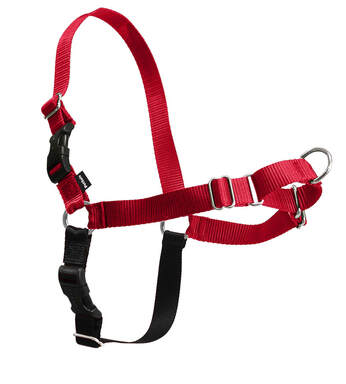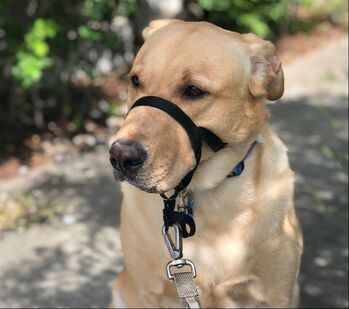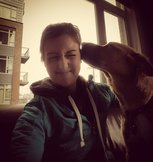You love spending time outside with your dog. The summer months are rolling in hot, but you still aren’t sure of the best way to train and/or walk your puppy, rescue, or long time family dog correctly.
The world of training, walking and running accessories are numerous and often confusing. I’ve compiled a list of extremely effective tools to use with your dog while out on a stroll!
The world of training, walking and running accessories are numerous and often confusing. I’ve compiled a list of extremely effective tools to use with your dog while out on a stroll!

Harnesses
Harnesses are an extremely popular and effective tool to walking your dog.
I am starting with harnesses because I believe they are universally the most effective way to working with most any sized pup. Barring various levels of reactivity in a dog, they are one of the most capable ways to work with and control your animal on a walk.
FRONT CLIP and/or TIGHTENING HARNESS
The easy walk is a front lead harness that is designed to redirect a pulling dogs attention to you. It tilts their weight into the pull, and forces them to make a turn; therefore, a very effective way to get their attention.
This is a great harness for dogs that need more directional control, have pulling problems, and have a hard time keeping focus on the walk itself.
STANDARD FRONT & BACK HARNESS
Though very similar to the easy walk harnesses, this harness allows for a tighter fit around the body. As well, an attachment to both the back and front of the dog. This allows for dynamic versatility, and an alteration that is more effective for smaller dogs.
Using the back hook on smaller dogs is an effective way to monitor control - given they wont be able to pull you. As well, guiding them to safety without tossing them around with a pull from the front. However, this means the opposite for medium plus breeds. If there are behavioral issues, you will have a much harder time maintaining control.
These will also be less inclined to tangle with the dogs legs, they protect a fragile neck area, and they are easy to put on and comfortable.
Harnesses are an extremely popular and effective tool to walking your dog.
I am starting with harnesses because I believe they are universally the most effective way to working with most any sized pup. Barring various levels of reactivity in a dog, they are one of the most capable ways to work with and control your animal on a walk.
FRONT CLIP and/or TIGHTENING HARNESS
The easy walk is a front lead harness that is designed to redirect a pulling dogs attention to you. It tilts their weight into the pull, and forces them to make a turn; therefore, a very effective way to get their attention.
This is a great harness for dogs that need more directional control, have pulling problems, and have a hard time keeping focus on the walk itself.
STANDARD FRONT & BACK HARNESS
Though very similar to the easy walk harnesses, this harness allows for a tighter fit around the body. As well, an attachment to both the back and front of the dog. This allows for dynamic versatility, and an alteration that is more effective for smaller dogs.
Using the back hook on smaller dogs is an effective way to monitor control - given they wont be able to pull you. As well, guiding them to safety without tossing them around with a pull from the front. However, this means the opposite for medium plus breeds. If there are behavioral issues, you will have a much harder time maintaining control.
These will also be less inclined to tangle with the dogs legs, they protect a fragile neck area, and they are easy to put on and comfortable.

HEAD HALTER
If your dog is an extremely strong puller, then I recommend a head halter. More so than the front-clip, this will force your dog back to you; therefore, allowing you a much stronger, and more full range of control of their direction.
These gentle-leads may look like a muzzle, but if you see one wearing them, or are thinking to get one yourself, be aware they are a completely pain free option for potentially more free moving dogs.
Be aware that you may deal with a bit of irritation when first using a head halter, it is completely foreign to dogs at first. But with some time and proper treat training they are sure to wear it just like any collar/leash.
A quick tip: With the front leads and halters, allow your dog to control the momentum. DO NOT yank them, allow them to simply guide themselves back to you. This could otherwise cause injury.
If your dog is an extremely strong puller, then I recommend a head halter. More so than the front-clip, this will force your dog back to you; therefore, allowing you a much stronger, and more full range of control of their direction.
These gentle-leads may look like a muzzle, but if you see one wearing them, or are thinking to get one yourself, be aware they are a completely pain free option for potentially more free moving dogs.
Be aware that you may deal with a bit of irritation when first using a head halter, it is completely foreign to dogs at first. But with some time and proper treat training they are sure to wear it just like any collar/leash.
A quick tip: With the front leads and halters, allow your dog to control the momentum. DO NOT yank them, allow them to simply guide themselves back to you. This could otherwise cause injury.




 RSS Feed
RSS Feed

